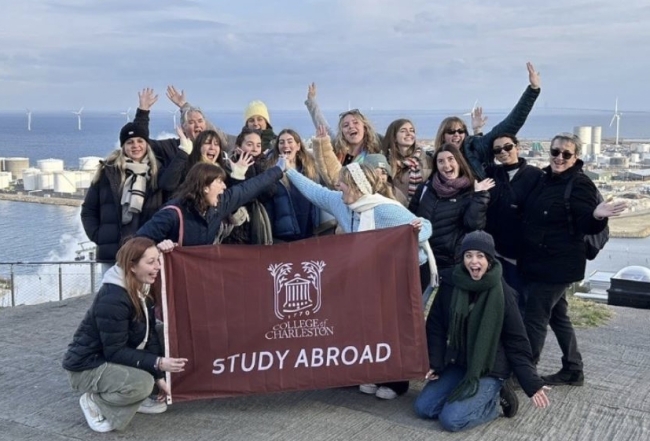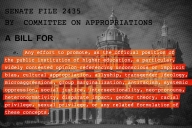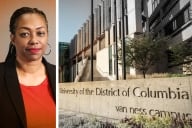You have /5 articles left.
Sign up for a free account or log in.

College of Charleston students enjoy a guided tour of the Amager Bakke power waste-to-energy plant during their recent visit to Denmark.
Lisa Ross
The stereotypical college spring break is a study in excess. Last month, 14 first-year students at the College of Charleston eschewed this tradition, instead studying sustainability—both environmental and personal—in Scandinavia.
The nine-day trip, which culminated two months of study of hygge (the Danish notion of coziness and contentment) and sustainability, was organized by Lisa Ross and Jen Wright, both professors of psychology. Their goal for the trip and accompanying one-credit course was to help students explore why Denmark consistently ranks as one of the happiest and most environmentally sustainable countries in the world, and whether and how those two things are connected.
Spoiler: Wright and Ross say they are, in ways that speak to some of the timeless questions college students ask themselves (What’s worth pursuing in life? What makes me happy?), in addition to more contemporary concerns (What’s the point of spending so much time on social media, anyway? How does materialism impact my mental health?).
What’s the need: Wright explains that today’s students “struggle with their happiness—they struggle with understanding how to be happy.” Yet ultimately, she says, underscoring the message of the course, “you don't need a lot to lead a good life. You don't need a lot of stuff. You just need a few friends, you need some close connections. You need a good job that makes you happy and you need to live someplace that makes you happy. So it’s not that complicated.”
Some students who signed up for the trip were originally more interested in environmental issues, Wright recalls. Others were more interested in exploring the concept of happiness. Yet as the journey progressed, students “really started to appreciate how interwoven they are, that these are not separate and distinct problems.”
“Good life” courses and happiness studies have been around for a long time, but an increasing number of colleges are offering them in light of what’s been described as the collegiate mental health crisis. The Denmark trip puts some new spins on this trend, offering first-year students, in particular, a chance to read up on happiness through a sustainability lens in a small community before traveling abroad to study the Danish good life up close.
Says Wright, “One of the things we struggle with, especially with first-year students, is trying to help them to understand that college isn’t high school, and you want to click on the flame that is love of learning.”
A meaningful, if abbreviated, study abroad experience is one way to do that, she continues. Not only can it boost students’ sense of self-efficacy, it “helps light that fire a little bit, helps students think about, ‘You could continue these studies, you could continue learning more about these things. There are so many classes that go deeper into these issues that you’ve been thinking about on this trip. Isn't that exciting?’”
Ross adds, “I think our students feel more connected to the College of Charleston because they’ve connected with each other. They’ve connected with us.”
How it works: Students met weekly for two months preceding the trip as part of the one-credit seminar course called Happiness and Sustainability in Denmark. The course and trip were optional but connected to a larger first-year experience initiative at the College of Charleston. The course centered on hygge and the effects of materialism on the planet and on individual mental health. Each student also chose a related topic of interest to research—including through spontaneous interviews with locals during the trip itself. Some possible research topics are green energy; bicycling, transportation and infrastructure; education; work-life balance; and relationship with nature.
“This may be a student’s first time out of their home country, so this will be an opportunity to see how different cultures ‘do things’ differently and this may result in a deeper understanding about how their own culture has shaped who they are as an individual,” the course’s syllabus defines long-term outcomes. “An increase in global thinking may deepen their outlook about how humans are the same yet different around the world. Also, this trip may spark an interest in further travel and it may spark changes in one’s own life with regards to nurturing relationships and living more simply.”
Assignments included a goals and self-description paper, to be completed at the beginning of the course, based on questions such as:
- Who are you?
- Describe one way “culture” has impacted your development thus far and how you see yourself.
- Do you have certain habits or activities that you can count on to boost your mood or bring you happiness? If so, what are they?
- What do you think of when you hear the word “sustainability?” Does this apply to your life and if so, how?
- What have your experiences been thus far with travel in the U.S.? With global travel?
- What are your goals for the course, including your expected final grade?
In addition to an interview summary report related to the student’s special topic of interest, the course also requires students to complete a post-trip personal reflections and self-assessment paper. Questions include:
- To what extent have you met your initial course goals?
- Have your views on culture, happiness, or sustainability changed, and if so, in what ways?
- What was the most important thing you learned in this course?
- How might what you’ve learned in this class relate to your career plans or your career path?
A group dinner in Charleston immediately proceeded the trip. The Denmark agenda included a hygge and happiness walking tour of Copenhagen led by a local guide; a visit to the Happiness Museum and Happiness Research Institute; a guided tour of the Amager Bakke power waste-to-energy plant; and a trip to the island of Bornholm. Students also fit in a short visit to neighboring Malmo, Sweden.
Ross, who was the course’s director of record, says the trip itself was a good mix of structured and unstructured activities, from the “fascinating” tour of Amager Bakke, an international symbol of sustainability, to “serendipitous” interactions with locals.
She recounts one moment from the trip to Bornholm: “It’s a very special place known for their green energy and sustainability focus, and the people there seemed so happy—and students pick up on that. We had a trio of students walking around this little tower, taking pictures of a cat or of trees or something. And this lady walks out of her house and says, ‘Oh, hello, would you like to come meet my other cat?,’ and invites these young women into her home … So they spent a little bit of time with this woman, and got to see a very tiny home with what seems to be a very happy Dane living there.”
The trip was partially subsidized by the college’s First-Year Experience program, but students still had to pay for most of their expenses. Wright, who runs additional study abroad programs at the college, adds that “the more we recognize the value of these kinds of experiences for students, the more we should try to find ways to make them possible to do without being yet another economic burden on families.”
Share your best tip (or two) for helping to ensure study abroad experiences have maximum impact for students.









